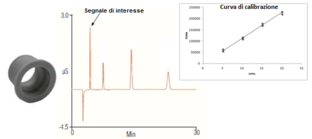Ion chromatography is involved in order to separate, identify and then quantify ionic or ionisable substances. This technique is based on the exchange reactions between ions that are contained in solutions and ions that lay on a solid. In ion chromatography stationery phase is a solid that contains ion groups combined with counterions. During the elution phase a ionized group is a solution that contains ions that can be combined with the ions contained in the sample suitable for reinforced sites during stationary phases. During the selection process between mobile phase and stationary phase it is possible to separate ionic or ionizable substances both inorganic or organic.
- Laboratory
- Instruments
- FT-IR spectrophotometers
- Calorimetro a scansione differenziale (DSC)
- Additives Extractor
- Optical Microscopy
- Atomic Absorption Spectroscopy (AAS)
- Ion-exchange chromatograph (IC)
- Mechanical testing: Dynamometer, Pendulum (IZOD), Durometer (Shore A-D)
- Dynamometer with CLIMATIC ROOM
- Thermal Testing: HDT Vicat
- Reaction to fire testing: UL94, Glow Wire Test
- Rheological Testing: Melt Index (MFR-MVR), Relative viscosity for polyamides
- Other Tests: Density, Polyamide moisture content, Colour Measurement
- News
- Faq
- Contact us

